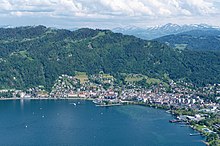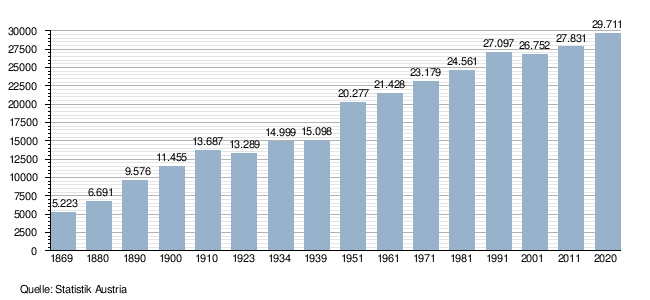Bregenz
![]()
The title of this article is ambiguous. For other meanings, see Bregenz (disambiguation).
Bregenz (standard German pronunciation: [ˈbreːɡɛnt͡s], ![]() , Vorarlbergian: [ˈbreaɡɐt͡s]) (Latin: Brigantium) is the provincial capital of the Austrian state of Vorarlberg and capital of the district of the same name. The city has the most important Austrian port on Lake Constance, and is a railway junction as well as a sports and cultural centre. In terms of population, Bregenz is the third largest city in Vorarlberg after Dornbirn and Feldkirch, but the agglomeration is more than twice the size of the city itself.
, Vorarlbergian: [ˈbreaɡɐt͡s]) (Latin: Brigantium) is the provincial capital of the Austrian state of Vorarlberg and capital of the district of the same name. The city has the most important Austrian port on Lake Constance, and is a railway junction as well as a sports and cultural centre. In terms of population, Bregenz is the third largest city in Vorarlberg after Dornbirn and Feldkirch, but the agglomeration is more than twice the size of the city itself.
Geography
Location
Bregenz is located in the westernmost province of Austria, east of Lake Constance, north of the city of Dornbirn and the Bregenzer Ach river. The capital of Vorarlberg is situated between the mountain slope of the Pfänder ridge with the Gebhardsberg advanced towards the west and the eastern shore of Lake Constance on the terraces of the upper town and the Ölrain as well as in the shore area of the lake. In more recent times, the settlement area expanded more towards the slopes of the Pfaender and Gebhardsberg, but mainly towards the southwest, where the settlements of Rieden-Vorkloster were established. These were incorporated in 1919. Further settlement expansions were made along the Bregenzer Ach, where for example the Achsiedlung was created. The former community of Fluh was incorporated in 1938.
Sea level
The highest point of the municipality lies at over 1000 m above sea level just south of the Pfänder peak in the Fluh district; the lowest point is the water surface of Lake Constance with an average altitude of 396 m above sea level. Lake Constance is also the lowest point in Vorarlberg. The city centre of Bregenz, the lowest point in Vorarlberg, lies at 398 m above sea level.
City breakdown
The political municipality of Bregenz consists of three cadastral municipalities (area as of 31 December 2019):
- Bregenz (936.41 ha)
- Fluh (585.97 ha)
- Rieden (1,400.58 ha; incorporated 1919)
The four districts Vorkloster, Stadt, Rieden (where the Riedenburg Monastery is also located) and Fluh are located in these cadastral municipalities. Until 1912 Kennelbach was also a part of Rieden. In addition, the separate district of Fluh (incorporated in 1938/1945) on the slopes of Pfänder and Gebhardsberg forms a third cadastral municipality. In the municipality of Bregenz, certain localities are described in the form of Ried names; these (e.g. Schendlingen, Am Stein, Funkenbühel, Hinterfeld, Ölrain, Thalbach, Brittenhütten) were already mentioned in the original map from 1857.
The municipality is divided into two villages (in parentheses: number of inhabitants as of 1 January 2021):
- Bregenz (29,199)
- Flood (335)
Neighboring communities
Bregenz lies on the eastern shore of Lake Constance. Bregenz borders Lindau, and thus Germany, via a narrow strip of shore extending northwards before Lochau along the easternmost part of the lake. This border extends over a few hundred metres in the estuary area of the Leiblach (middle of the river).
The Bregenzer Ach forms the border to the neighbouring communities of Lauterach and Hard in the south and southwest. It then flows into Lake Constance between Bregenz and Hard. The Pfänderbahn (Pfänder railway) has been running since 1927 to the Pfänder, Bregenz's local mountain (1064 m above sea level), the southern flank of which is formed by the Gebhardsberg. Bregenz is 502 km west of Vienna as the crow flies.
Lake facilities
The beginning of the lake facilities was a lakeside path in 1842. The expansion continued with the ship harbour, which was started in 1842 and the "Molo" was completed in 1890. The railway area was filled in and the lakeside promenade built in 1900, under which an oil pipeline has been running since about 1965, was extended in the direction of Lochau with the excavated material produced during the construction of this pipeline.
Urbanistically, however, the city was cut off from the lakeshore by this railway line at the time. This would have been exacerbated by the parallel motorway route planned in the 1960s. Although a referendum in 1960 resulted in a 90-percent rejection of the lakeshore route, it was still pursued by the federal government. In January 1969, the people of Bregenz rose up in massive opposition, which ultimately led to the routing of the motorway through the Pfändertunnel.
In 2009 and 2010 the harbour and lake facilities were redesigned. A new harbour building ("Wave") was built. Concrete seating was created at the Flower Molo ("Sunset Steps"), a new lighthouse was built. Since 2014, the "Pipeline", the 1.7 km long Lake Constance access between Bregenz harbour and Lochau, colloquially known due to the construction of the oil pipeline, has been successively redesigned so that a new beach with a shallow sloping shore is created.
Agglomeration
About 63,000 people live in the conurbation of Bregenz. In addition to Bregenz (28,000), this coherent settlement area also includes Hard (13,000), Lauterach (10,000), Wolfurt (8,000), Kennelbach (2,000) and Lochau-Süd (2,000). In addition, a band of settlements connects the cities of Bregenz and Dornbirn more and more into an agglomeration with over 100,000 inhabitants.
Climate
Bregenz has a maritime climate (Cfb).
| Bregenz | ||||||||||||||||||||||||||||||||||||||||||||||||
| Climate diagram | ||||||||||||||||||||||||||||||||||||||||||||||||
| ||||||||||||||||||||||||||||||||||||||||||||||||
| Monthly average temperatures and precipitation for Bregenz
Source: ZAMG climate averages 1981 - 2010 | |||||||||||||||||||||||||||||||||||||||||||||||||||||||||||||||||||||||||||||||||||||||||||||||||||||||||||||||||||||||||||||||||||||||||||||||||||||||||||||||||||||||||||||||||||||||||||||||||||||||||||||||

The four districts of Bregenz

Aerial view of Bregenz from June 2021
Population
Population development

Population structure
The age structure of the population in Bregenz differed slightly from the average in Vorarlberg in 2011. While 15.7 % of the population in Bregenz was under 15 years of age, the figure for the province was 16.6 %. The proportion of the population over 65 was 17.1%, which was higher than the Vorarlberg average of 15.7%. With regard to the employment rate of the 15-64 year olds, Bregenz with a value of 65.0% was clearly below the Vorarlberg value of 70.9%. The unemployment rate of 8.1%, on the other hand, was significantly higher than the Vorarlberg average of 5.0%. In 2011, 47.9 % men and 52.1 % women lived in Bregenz.
Educational background
In 2011, 50.7% of Bregenz residents had a secondary degree (AHS, BMS, BHS or apprenticeship) and 12.7% had a tertiary degree (university, academy or college degree) as their highest completed education, which is higher than the Vorarlberg average of 9.4%.
Search within the encyclopedia